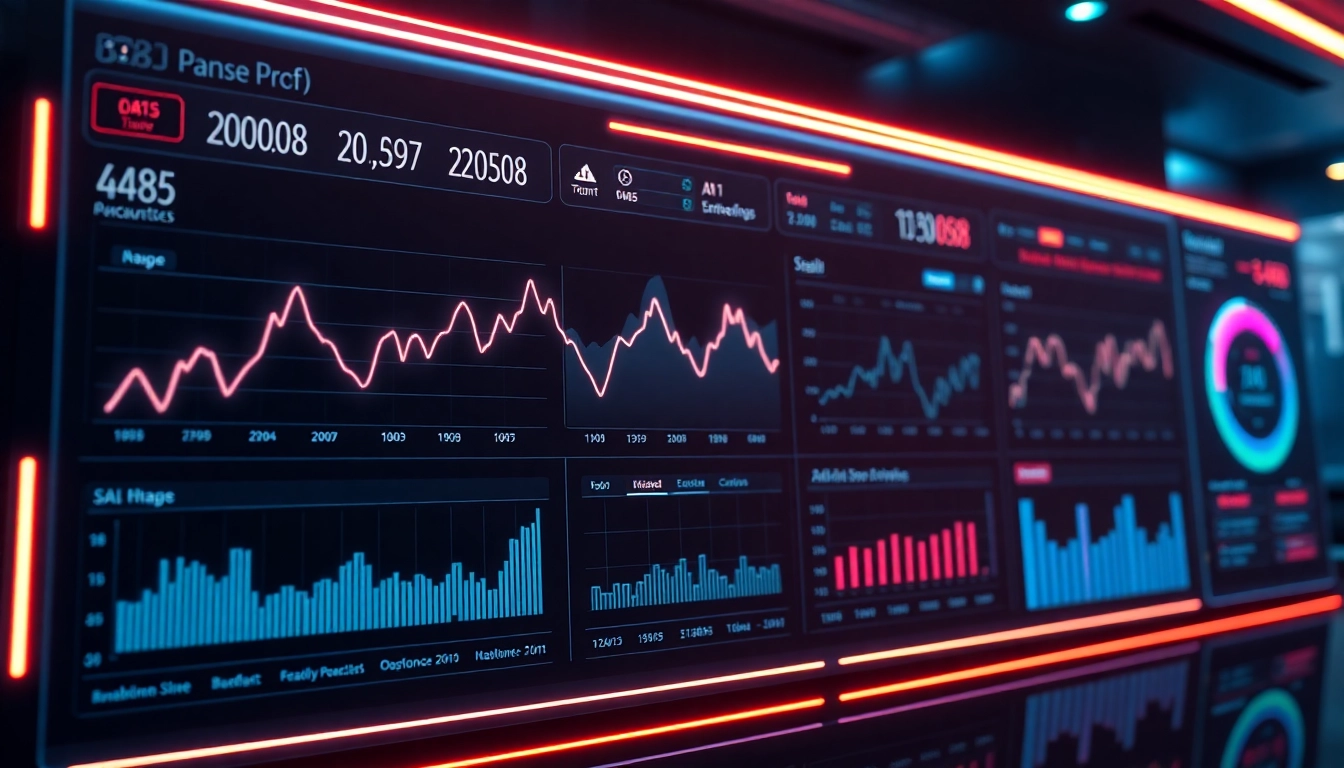Introduction to Trading View and Its Key Features
In today’s fast-paced financial markets, traders and investors require powerful tools to analyze, monitor, and execute trades efficiently. One platform that has gained widespread recognition for its comprehensive features and user-friendly interface is trading view. This platform has revolutionized how market participants access real-time data, perform technical analysis, and engage with a vibrant community of traders worldwide. Whether you are a seasoned professional or a beginner stepping into the world of trading, understanding the core functionalities of trading view can significantly enhance your trading strategy and decision-making process.
What is Trading View and Why It Matters
Trading view is more than just a charting platform; it is an all-in-one financial analysis ecosystem that combines charting tools, social networking, and trading capabilities into a single interface. Originating as a browser-based service, it now offers mobile applications and seamless integration with various trading brokers, making it accessible across devices. Its importance lies in its ability to democratize market analysis—providing traders from across the globe access to professional-grade tools without the need for expensive software or complex setups.
By aggregating financial data from thousands of markets—including stocks, cryptocurrencies, forex, commodities, and indices—trading view serves as a central hub for market analysis. Its social features enable traders to share ideas, strategies, and insights, fostering a collaborative environment that accelerates learning and strategy refinement. The combination of real-time data, customizable charts, and a supportive community makes trading view indispensable for those aiming to stay ahead in competitive markets.
Core Tools and Charting Capabilities
At the heart of trading view are its sophisticated charting tools. Offering an extensive library of more than 100 technical indicators, drawing tools, and customizable templates, it allows users to conduct meticulous technical analysis. Features such as multiple chart layouts, minute-by-minute updates, and advanced drawing options—like trend lines, Fibonacci retracements, and Elliott wave analysis—equip traders with the ability to identify potential entry and exit points with precision.
The platform supports a variety of chart types, including candlestick, bar, line, and Heikin Ashi, enabling traders to adapt their analysis to different market conditions. Additionally, the ability to synchronize multiple charts for different assets or timeframes provides a holistic view of market trends. The real-time updates ensure that traders can react promptly to market movements, minimizing latency and maximizing trading opportunities.
For example, a trader analyzing Bitcoin might overlay Moving Averages and RSI (Relative Strength Index) to identify bullish or bearish signals. Custom scripts and indicators created via Pine Script—a proprietary scripting language—allow for further personalization, automated strategies, and backtesting. This flexibility ensures that traders can tailor their analysis environment to fit unique trading styles and hypotheses.
Social Trading and Community Insights
One of trading view’s standout features is its social trading aspect. The platform’s integrated social network facilitates idea sharing, discussion, and collaboration among traders worldwide. Users can publish charts, ideas, and forecasts, which others can comment on or replicate. This fosters a community-driven approach to market analysis, where collective intelligence enhances individual strategies.
Community insights often include educational content, trading lessons, and real-time market updates—making it a valuable resource for traders to learn and adapt. Popular features like “Ideas” allow users to explore trending forecasts, validate their analysis, or gain alternative perspectives. For instance, during major economic events or earnings seasons, seeing how other traders interpret the data can lead to better-informed decisions.
Moreover, real-time chat rooms and group discussions enable rapid exchange of strategies and market sentiment. This social aspect not only aids in idea validation but also helps traders stay emotionally resilient by understanding the broader market consensus amidst volatility.
Getting Started with Trading View
Creating Your Account and Setting Preferences
Starting with trading view requires creating a free account on their platform. The registration process is straightforward, offering options to sign up via email or social media accounts. Once logged in, users can customize their profile and set preferences for chart types, timeframes, and language options. This personalization ensures a more seamless and efficient analysis workflow.
Customizing Watchlists and Alerts
A key advantage of trading view is its ability to create watchlists—collections of specific assets tracked for quick access. Users can add stocks, cryptocurrencies, forex pairs, or indices to their watchlists and organize them according to preferences. Alerts can be set on price levels, indicator crossings, or pattern developments, delivering timely notifications directly to your device. This proactive approach allows traders to act swiftly on market opportunities or risk warnings.
Integrating Trading View with Other Platforms
Trading view seamlessly integrates with several major brokerage platforms, enabling direct trading from charts. This integration simplifies order execution and position management. Furthermore, the platform offers APIs and export options, allowing users to incorporate its data into custom tools or third-party applications. Such connectivity streamlines the entire trading process, from analysis to execution, saving valuable time and reducing errors.
Advanced Trading Strategies Using Trading View
Technical Analysis and Pattern Recognition
Trading view’s robust charting environment facilitates advanced technical analysis, including recognition of chart patterns like head and shoulders, triangles, and flags. Automated pattern recognition tools help traders identify these formations more efficiently. Combining multiple indicators can also validate trend reversals, continuation signals, and breakout points, making technical analysis more accurate.
Implementing Automated Trading and Scripts
Through Pine Script, traders can develop custom algorithms for automated trading, alerts, and analysis. This scripting capability enables backtesting strategies on historical data, refining parameters before live deployment. Automated trading reduces emotional biases and ensures consistent execution according to predefined rules.
Backtesting and Performance Tracking
Backtesting allows traders to evaluate how a strategy would have performed historically, offering insights into possible profitability and risk. Trading view provides detailed performance reports, including drawdowns, win/loss ratios, and expectancy. Regular performance tracking helps traders adapt their strategies, optimize risk management, and improve overall profitability.
Optimizing Your Market Analysis Workflow
Utilizing Multiple Indicators Effectively
Successful analysis often involves combining various indicators such as Moving Averages, Bollinger Bands, MACD, and Fibonacci levels. Trading view’s interface makes it easy to overlay and customize indicators, ensuring clarity without clutter. Understanding how to interpret combined signals reduces false positives and enhances decision accuracy.
Incorporating Community Ideas and Insights
Leverage the community’s collective intelligence by examining popular ideas and forecasts. Comparing your analysis with community insights provides validation or new perspectives. Engaging actively with the community also accelerates learning curves and keeps you updated on emerging market themes.
Staying Updated with Real-Time Market Data
Real-time market data is critical for effective trading. Trading view’s data feeds are updated frequently, often within seconds, ensuring your analysis reflects current market conditions. Setting custom alerts for breakouts or trend changes keeps you attentive without constant monitoring, empowering proactive trading.
Best Practices for Consistent Trading Success
Risk Management and Position Sizing
Effective trading involves managing risk meticulously. Use trading view’s tools to define stop-loss and take-profit levels clearly. Apply position sizing techniques aligned with your account size and risk appetite, ensuring that no single trade jeopardizes your capital.
Developing a Trading Routine with Trading View
Consistency stems from disciplined routines. Incorporate scheduled analysis sessions using trading view’s saved templates and watchlists. Regular review of charts, community ideas, and your trading journal helps reinforce good habits and adapt to evolving market conditions.
Analyzing Past Trades for Continuous Improvement
Maintain detailed records of your trades within trading view or external journaling tools. Post-trade analysis helps identify strengths and weaknesses, refine strategies, and reduce repeated mistakes. Continuous improvement is the hallmark of sustainable trading success.






